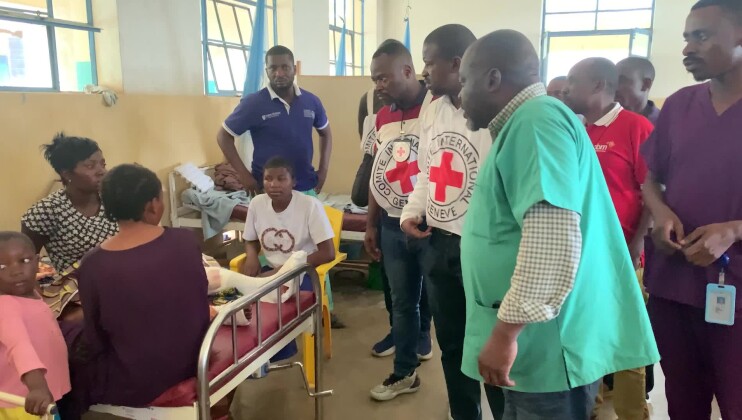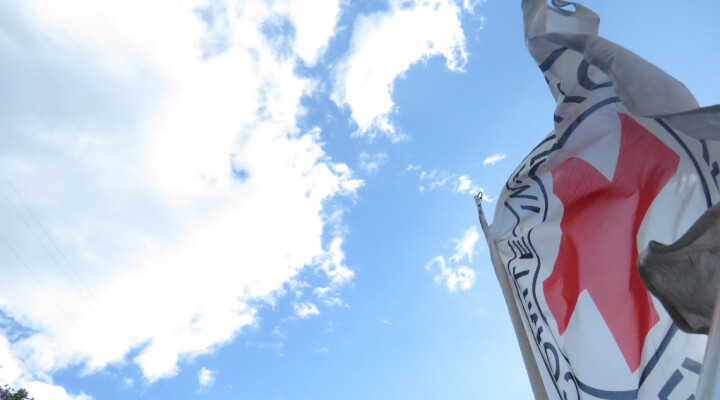Mali: Violence in Ogossagou indicative of deteriorating humanitarian situation in central Mali
SITUATION
Two weeks on from the attack on the village of Ogossagou, in which more than 161 people died according to official estimates, the apocalyptic scenes seem frozen in time.
The wind has covered everything in a layer of red dust: burned-out huts and farm buildings, houses riddled with bullet holes, the charred remains of cars anddead donkeys. The wells are unusable – contaminated by corpses. People’s livestock herds have been taken. Families are still struggling to come to terms with the shock of the massacre – the latest in a recent series of very violent clashes between herders and settled farmers in the region.
Seventeen-year-old Sadio Kelly, who survived the attack, describes what happened: “We didn’t have time to flee. Those who tried to were shot. They threw a lot of people down the well. That’s why we come to the pump for water now. They tried to destroy the pump too, but they didn’t succeed. They burned a lot of the huts where we kept livestock and food. They shot people. A bullet grazed my shoulder.”
People are trying to get on with their lives but the circumstances are dire.
The Mali Red Cross and the International Committee of the Red Cross (ICRC) began distributing food on 31 March to all the inhabitants of Ogossagou – over 1,500 people, Dogon and Peul alike. The Peul community also received household essentials, as 90% of their part of the village was destroyed.
The Mali Red Cross acted swiftly to transport 74 wounded people – of whom 43 were in a serious condition – from Bankass, the nearest town (some 20 km from Ogossagou), to Simone Dolo Hospital in Mopti. Measures have also been put in place to enable those who were taken for medical treatment to stay in contact with their relatives left behind in the village.
Abdoulaye Barry came to the hospital with his friend Boukary, who was wounded in the head: “Everything has been destroyed. All I have is this boubou that they gave me here. I escaped with my life and my breath.”
But it is the invisible wounds, buried deep in people’s hearts and memories, that are likely to leave more lasting scars. The ICRC immediately dispatched Insaf Mustafa, a psychologist specialized in providing post-crisis psychosocial support, to help the wounded find the words to talk about their distressing experiences:
“When we talk about traumatic events of this kind, the pain is not just physical. The damage is also psychological. Trauma is not expressed only through tears and sadness. It also has physical symptoms, like headaches, sleep problems or loss of appetite.”
As for the people left behind in the village, they live in fear of another attack. This fear is compounded by inactivity, as they can no longer farm their land and have lost their livelihoods.
The tragedy that occurred in Ogossagou is extremely worrying and highlights the deteriorating security situation and growing communal tensions in central Mali; the situation in the north of the country is also very volatile.
The deteriorating security situation has had complex humanitarian consequences, such as unprecedented numbers of people leaving their homes in search of safety, especially in the region of Menaka, on the border with Niger. It is also disrupting the natural resilience mechanisms developed by communities to cope with the effects of climate change and putting further strain on already very limited resources. Violence and flooding followed by drought are contributing to a humanitarian crisis affecting 7.2 million people in Mali, around 50% of whom are women and 19% children under five. Worn down by one blow after another, 3.2 million people lack food security and access to health care (according to a report released by the United Nations Office for the Coordination of Humanitarian Affairs (OCHA) in January 2019). The situation is also generating major internal displacement: in six months, the number of internally displaced people has doubled, reaching 120,000 throughout Mali – 54,000 in the central Mopti region alone (OCHA bulletin, December 2018).
The ICRC calls on all parties to show restraint, safeguard the civilian population and facilitate humanitarian organizations’ access to the region
For further information, please contact:
Emmanuel Kagimbura, ICRC Mali: +223 75995568
Françoise Lambert, ICRC Dakar, Regional Centre for West Africa: +221 781 864 687
Press team, ICRC Geneva: +41 79 217 32 32
Follow the ICRC on facebook.com/icrc and twitter.com/icrc
SHOTLIST
Location: Ogossagou, Mali
Duration: 7’39’’
Format: 1920 x 1080 .mov
Camera, production, editing: Birom Seck
Language: French
Date: April 2019
Copyright: ICRC – rights free
OGOSSAGOU VILLAGE
00:00 – 00:08 Driving into the Peul area of Ogossagou
00:08 – 00:15 Ogossagou signpost within a destroyed house (two shots)
00:15 – 00:40 SOUNDBITE: ALI BARRY, OGOSSAGOU VILLAGE CHIEF
00:15 – 00:22 Most of the burned bodies are buried here.
There are a dozen or so on the other side.
00:22 – 00:26 No, there are a lot more than that over there.
00:26 – 00:28 How many do you think there are over there?
00:28 – 00:33 I don’t know, but we buried the very charred bodies here
and the less burned ones over there.
00:33 – 00:40 So the charred bodies here and the less burned ones there.
00:40 – 00:45 Mass grave
00:45 – 00:56 Issa Ba discovers what’s left of the mosque (two shots)
00:56 – 01:11 SOUNDBITE: ISSA BA, OGOSSAGOU VILLAGE ELDER
00:56 – 00:59 They destroyed these vehicles.
00:59 – 01:02 They destroyed people’s homes. The damage is immense.
01:02 – 01:04 They ransacked our mothers’ homes.
01:04 – 01:08 They made sure they left nothing behind.
01:08 – 01:11 For the rest, we look to God.
01:11 – 01:18 Burned out vehicles with bullet holes (two shots)
01:18 – 01:26 A man extracts a bullet from a wall riddled with bullet holes (two shots)
01:26 – 01:30 Donkey with burns
01:30 – 01:34 Charred corpse of a donkey
01:34 – 01:37 Woman walking in the village
01:37 – 02:00 Scenes of the destruction in the village (seven shots)
02:00 – 02:04 Children walking in the village
02:04 – 02:10 A child alone in the fog (two shots)
02:10 – 02:13 Women on their way to the water pump
02:13 – 02:17 Women using the water pump
02:17 – 02:23 Sadio Kelly shows her friend her wound at the pump (two shots)
02:23 – 02:46 SOUNDBITE: SADIO KELLY, SURVIVOR, 17 YEARS OF AGE
02:23 – 02:28 We didn’t have time to flee. Those who tried to were shot.
02:28 – 02:31 They threw a lot of people down the well.
02:31 – 02:33 That’s why we come to the pump for water now.
02:33 – 02:35 They tried to destroy the pump too, but they didn’t succeed.
02:35 – 02:41 They burned a lot of the huts where we kept livestock and food.
02:41 – 02:46 They shot people. A bullet grazed my shoulder.
AID DISTRIBUTION IN OGOSSAGOU
02:46 – 03:09 Distribution of food and other essential items to Peul villagers in Ogossagou (seven shots)
03:09 – 03:13 ICRC and Mali Red Cross staff walking in the village
03:13 – 03:39 Distribution of food to Dogon villagers in Ogossagou (seven shots)
MOPTI HOSPITAL
03:39 – 03:46 Outside the hospital in Mopti (two shots)
03:46 – 03:52 A girl who was shot in the foot (two shots)
03:52 – 03:58 A breastfeeding woman who was shot in the leg (two shots)
03:58 – 04:02 A woman with a face wound
04:02 – 04:06 Abdoulaye Barry talks to his friend
04:06 – 04:17 SOUNDBITE: ABDOULAYE BARRY
04:06 – 04:14 Everything has been destroyed. All I have is this boubou that they gave me here.
04:14 – 04:17 I escaped with my life and my breath.
DISCUSSION GROUP FOR OGOSSAGOU SURVIVORS
04:17 – 04:21 Insaf Mustapha Charaf leads a discussion group for Ogossagou survivors
04:21 – 04:26 When you first talk about it, it’s true that it’s painful. But then, it can be soothing.
04:26 – 04:33 Hawa Barry takes part in the discussion group (two shots)
04:33 – 05:29 Discussion group participants (16 shots)
05:29 – 05:38 SOUNDBITE: AMADOU BARRY, 27 YEARS OF AGE, AN OGOSSAGOU VILLAGER
05:29– 05:31 These discussions are really important to us.
05:32 – 05:37 They help us to calm down. I find them really helpful.
05:38 – 05:44 Insaf listens to Hawa Barry, a Peul patient from Ogossagou who has just lost two of her children:
“Since my children were killed in the attack, I haven’t been able to sleep at night. I can’t forget.”
05:44 – 05:48 Insaf listens to Hawa Barry
05:48 – 05:52 Insaf holds Hawa’s hand
05:52 – 06:08 Various scenes of Hawa Barry with her daughter (four shots)
06:08 – 06:12 Hawa talks with her friend
06:12 – 06:16 Hawa says to her friend: “I won’t stay in Ogossagou.”
06:16 – 06:19 Hawa’s daughter in her arms
06:19 – 06:26 Hawa says to her daughter: “Are you thirsty?” (two shots)
06:26 – 07:06 SOUNDBITE: HAWA BARRY, 32 YEARS OF AGE, MOTHER OF THREE CHILDREN, TWO OF WHOM WERE KILLED DURING THE ATTACK ON OGOSSAGOU
06:26 – 06:30 Since I came here, I haven’t been able to sleep.
06:30 – 06:35 You can still suffer even when you share your pain, especially when your family is not with you.
06:35 – 06:42 When you’re not with your loved ones and something terrible happens, it’s very traumatic.
06:42 – 06:46 But I give thanks to God. It’s out of my hands.
06:46 – 06:52 I’m going to go home to find my family.
06:52 – 06:57 I hadn’t been in Ogossagou for very long.
06:57 – 07:03 God wanted us to be there during the attacks.
07:03 – 07:06 It was our fate.
07:06 – 07:39 SOUNDBITE: INSAF MUSTAPHA CHARAF, ICRC MENTAL HEALTH DELEGATE
07:06 – 07:14 When we talk about traumatic events of this kind, the pain is not just physical.
07:14 – 07:22 The damage is also psychological.
07:22 – 07:28 Trauma is not expressed only through tears and sadness.
07:28 – 07:39 It also has physical symptoms, like headaches, sleep problems or loss of appetite.
END



